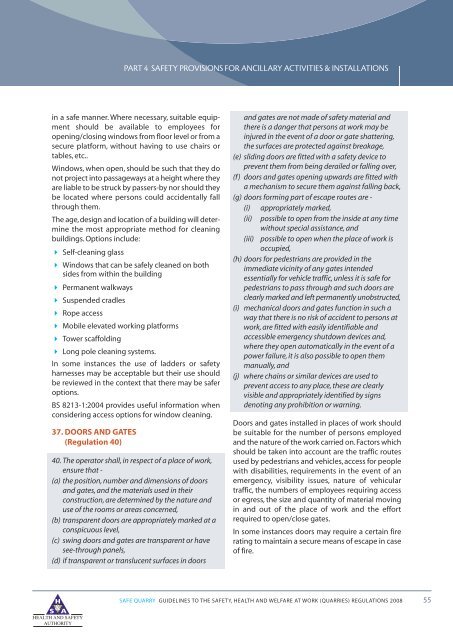Safe Quarry - Health and Safety Authority
Safe Quarry - Health and Safety Authority
Safe Quarry - Health and Safety Authority
Create successful ePaper yourself
Turn your PDF publications into a flip-book with our unique Google optimized e-Paper software.
PART 4 SAFETY PROVISIONS FOR ANCILLARY ACTIVITIES & INSTALLATIONS<br />
in a safe manner. Where necessary, suitable equipment<br />
should be available to employees for<br />
opening/closing windows from floor level or from a<br />
secure platform, without having to use chairs or<br />
tables, etc..<br />
Windows, when open, should be such that they do<br />
not project into passageways at a height where they<br />
are liable to be struck by passers-by nor should they<br />
be located where persons could accidentally fall<br />
through them.<br />
The age,design <strong>and</strong> location of a building will determine<br />
the most appropriate method for cleaning<br />
buildings. Options include:<br />
Self-cleaning glass<br />
Windows that can be safely cleaned on both<br />
sides from within the building<br />
Permanent walkways<br />
Suspended cradles<br />
Rope access<br />
Mobile elevated working platforms<br />
Tower scaffolding<br />
Long pole cleaning systems.<br />
In some instances the use of ladders or safety<br />
harnesses may be acceptable but their use should<br />
be reviewed in the context that there may be safer<br />
options.<br />
BS 8213-1:2004 provides useful information when<br />
considering access options for window cleaning.<br />
37. DOORS AND GATES<br />
(Regulation 40)<br />
40. The operator shall, in respect of a place of work,<br />
ensure that -<br />
(a) the position, number <strong>and</strong> dimensions of doors<br />
<strong>and</strong> gates, <strong>and</strong> the materials used in their<br />
construction, are determined by the nature <strong>and</strong><br />
use of the rooms or areas concerned,<br />
(b) transparent doors are appropriately marked at a<br />
conspicuous level,<br />
(c) swing doors <strong>and</strong> gates are transparent or have<br />
see-through panels,<br />
(d) if transparent or translucent surfaces in doors<br />
<strong>and</strong> gates are not made of safety material <strong>and</strong><br />
there is a danger that persons at work may be<br />
injured in the event of a door or gate shattering,<br />
the surfaces are protected against breakage,<br />
(e) sliding doors are fitted with a safety device to<br />
prevent them from being derailed or falling over,<br />
(f) doors <strong>and</strong> gates opening upwards are fitted with<br />
a mechanism to secure them against falling back,<br />
(g) doors forming part of escape routes are -<br />
(i) appropriately marked,<br />
(ii) possible to open from the inside at any time<br />
without special assistance, <strong>and</strong><br />
(iii) possible to open when the place of work is<br />
occupied,<br />
(h) doors for pedestrians are provided in the<br />
immediate vicinity of any gates intended<br />
essentially for vehicle traffic, unless it is safe for<br />
pedestrians to pass through <strong>and</strong> such doors are<br />
clearly marked <strong>and</strong> left permanently unobstructed,<br />
(i) mechanical doors <strong>and</strong> gates function in such a<br />
way that there is no risk of accident to persons at<br />
work, are fitted with easily identifiable <strong>and</strong><br />
accessible emergency shutdown devices <strong>and</strong>,<br />
where they open automatically in the event of a<br />
power failure, it is also possible to open them<br />
manually, <strong>and</strong><br />
(j) where chains or similar devices are used to<br />
prevent access to any place, these are clearly<br />
visible <strong>and</strong> appropriately identified by signs<br />
denoting any prohibition or warning.<br />
Doors <strong>and</strong> gates installed in places of work should<br />
be suitable for the number of persons employed<br />
<strong>and</strong> the nature of the work carried on.Factors which<br />
should be taken into account are the traffic routes<br />
used by pedestrians <strong>and</strong> vehicles, access for people<br />
with disabilities, requirements in the event of an<br />
emergency, visibility issues, nature of vehicular<br />
traffic, the numbers of employees requiring access<br />
or egress, the size <strong>and</strong> quantity of material moving<br />
in <strong>and</strong> out of the place of work <strong>and</strong> the effort<br />
required to open/close gates.<br />
In some instances doors may require a certain fire<br />
rating to maintain a secure means of escape in case<br />
of fire.<br />
SAFE QUARRY GUIDELINES TO THE SAFETY, HEALTH AND WELFARE AT WORK (QUARRIES) REGULATIONS 2008 55
















